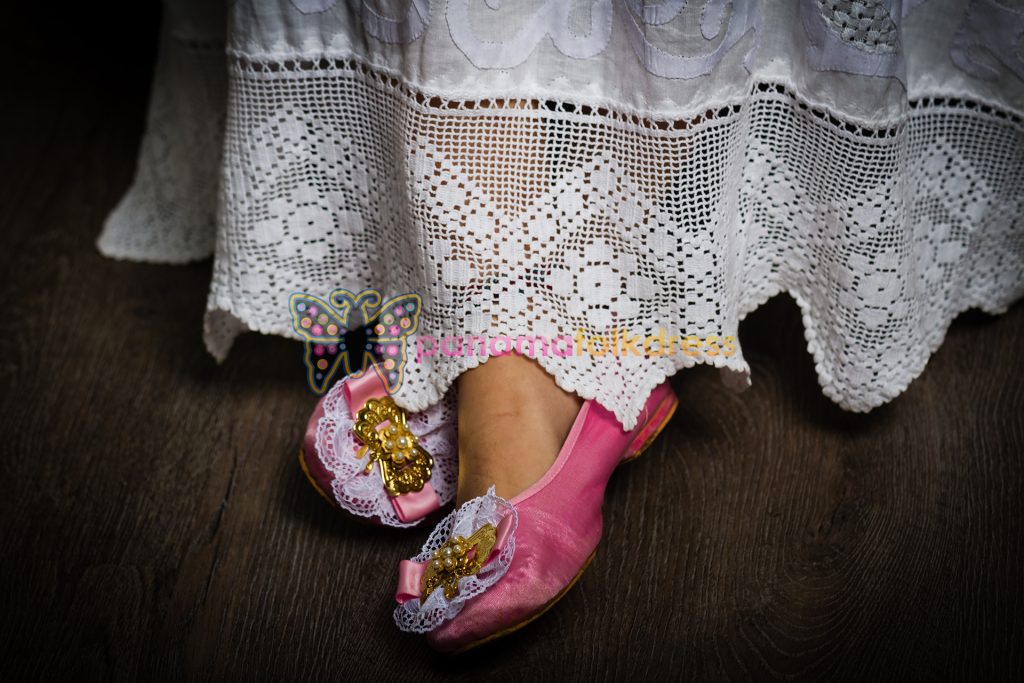Head Jewelry
The oval and straight cut-off large size combs: In a survey in the area of Las Tablas, we investigated that most of the “empolleradas” of these regions, frequently used the oval comb, large size in tortoiseshell and gold, the straight cut (comb with a curve shape similar to a roof tile) adorned with beads, glitters or without them.
The use of oval section combs was not widespread. The heads were adorned with two or three pairs of combs, the shiny or brightest with pearls, balconies shapes or the ones wearing corals. Two pairs were placed on each side of the head, another pair in the space left by them in the back.
The use of the oval comb was extended across all the Azuero Peninsula, when the road linking the central provinces to Panama City was built during the administration of Dr. Belisario Porras and became the complement of the empolleradas.
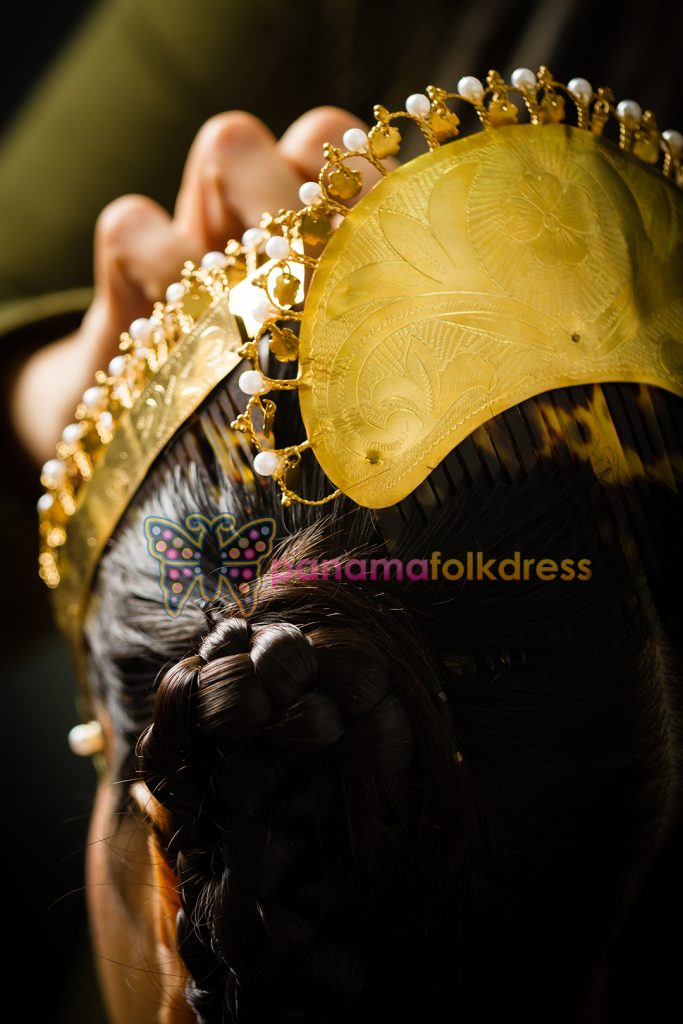
Hair Combs:
In Los Santos region, the combs with “Steal hearts” were not used much; those in the coffers are acquired recently. Generally, the combs are straight cut and without steal hearts. In our view, the spiral of gold of the combs with “Steal hearts” does not fit in addition to the ornaments worn by the empolleradas. These spirals combs are used in “Ocu” and its countryside. The patches or thoughts are more popular in other provinces.
Patches or Golden Thoughts:
They consist of two small gold square slats that have in the center a natural or cultured pearl. Originally it was used to hide the “caraña” and relieve headaches caused by the weight of the headdress. Currently, they are only worn as ornaments to attend certain festivals.
Earrings for Pollera:
There are a variety of earrings that can be used with the Pollera. The most popular are the tendrils, the mosqueta, sleepy, tangos and gold rings.
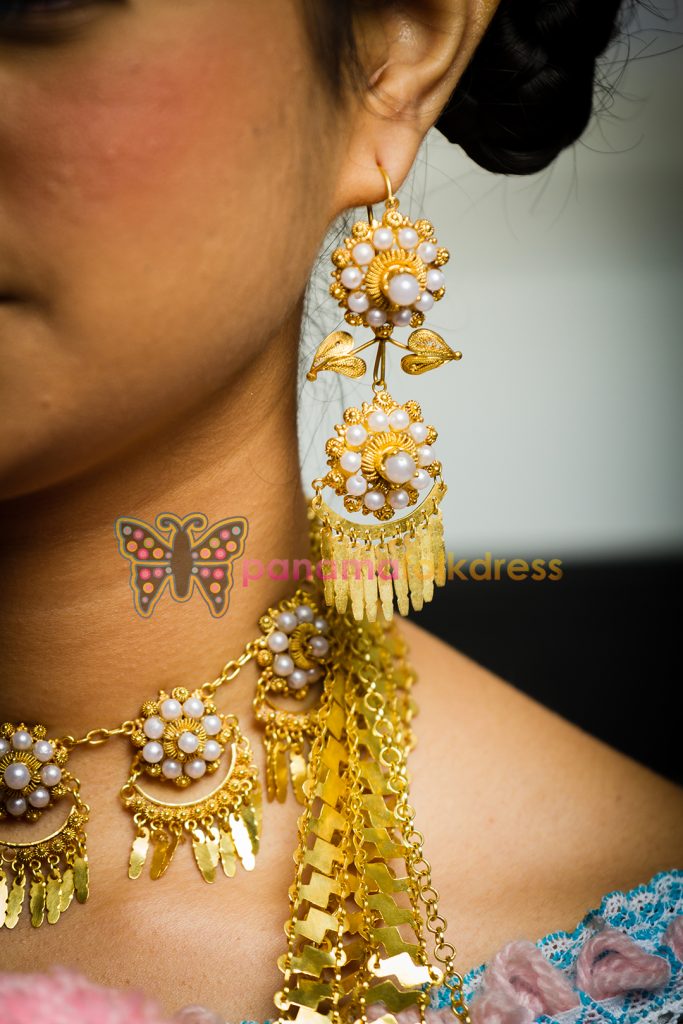
The Tendrils(Zarcillos):
Tendrils are composed of three detachable parts: a small gold rosette with precious stones, a bow or a couple of leaves of gold and a piece like the first but larger. At the end of it, a series of shinny inserts called “bright” are linked together and they are constantly moving.
Tendrils can be adorned with colored stones in different shapes and sizes, the most common are: rubies, emeralds, topaz and jet black.
There are tendrils in the “sleepy shape”, formed with two coins adorned with filigree edges and tomatillos, the first piece that holds the coin is fixed to the ear clip, and the other is suspended with a crescent of bright twinkling slats.
Mosqueta (bee catcher):
There are mosquetas worked in tomatillos with filigree and adorned with legitimate pearls. The mosqueta is named that way because it resembles the bees that crawl the flowers. The mosqueta is often seasoned with an oval pendant trimmed with gold, pearl shell and tomatillos.
Dormilonas (the sleepers):
These earrings consist of a small coin with machined edges and a crescent moon holding a row of shiny inserts. They come in other shapes and decorations as well.
The Tangos and gold rings:
They are worked with pearls or coral. The gold bearing bonds with tears are more popular in the region of Los Santos.
Earrings designs for the Pollera are reminiscent of those worn by women in Mexico, Central and South America. There are a variety of Panamanian models; some are traditional and other creations of popular goldsmiths.
Panamanian Necklaces
The Tapahueso is a velvet or satin ribbon with a gold cross or medal, is used to cover the dimple of the throat, which is an aristocratic detail, very fashionable in Europe to decorate the neck of the ladies when they carry large cleavage.
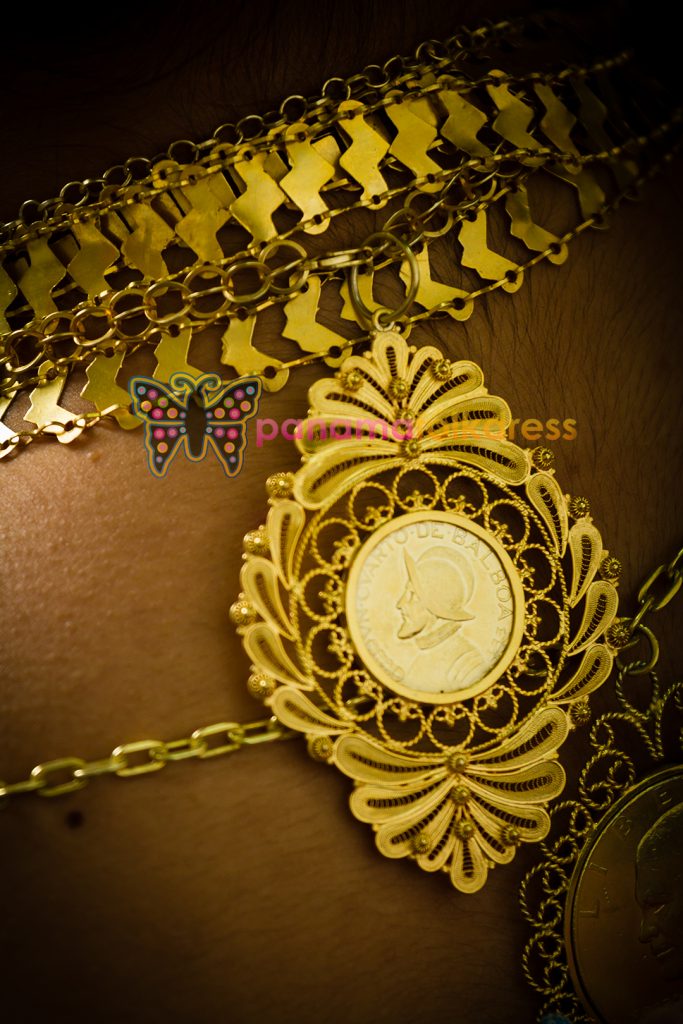
The necklaces have beautiful works in burnished opaque gold, water-marked in different colors, with shapes of hearts, anchors, butterflies, etc … These also can hold precious stones, pearls and filigree.
This gem is best to replace the velvet ribbon or black satin that is used with a cross or medal around the neck. It should be noted that the last was made to wear with the Pollera Montuna and its use is accepted for “Gala Polleras”.
Jewelry for the Chest
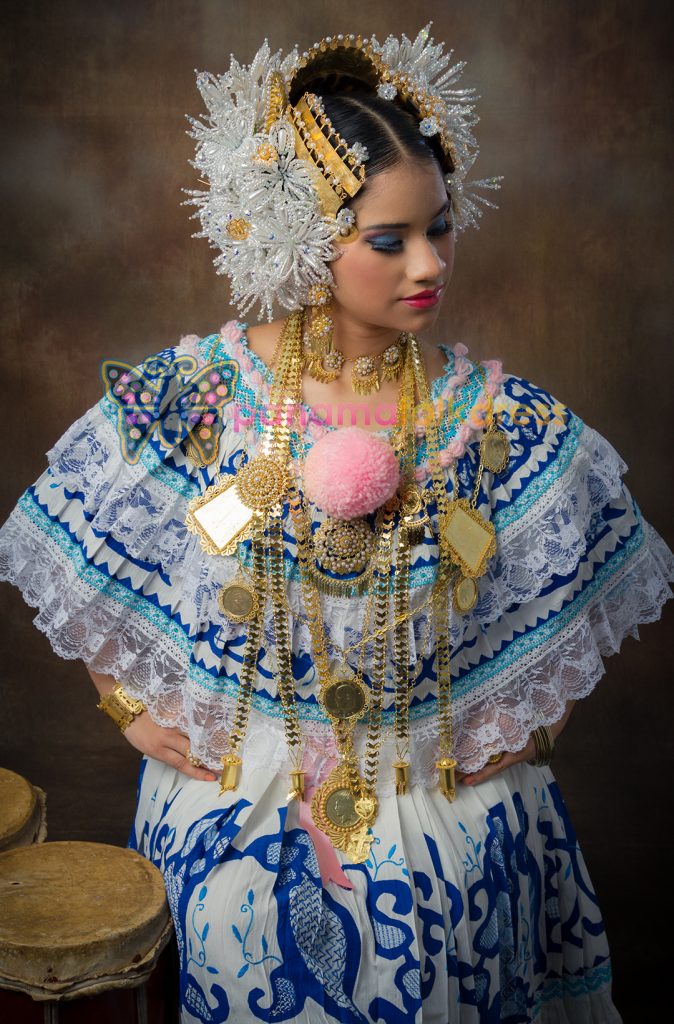
Cabestrillo (Sling):
It’s a crowned shield chain reminiscent of the decorations that were used in earlier times in European courts. Many of these slings hold coins with portraits of kings and crowns of the Spanish nobility.
Traditionally, coins are placed from largest to smallest. The largest ones are placed the sides and the others are spread in pairs in the chain.
In relation to the ornaments for this chain, it is rare to see the use of stones inserts on the edges. If this chain is oversized it removes the striking look of the rest of the chains.
Some slings are so long that they can pass two times around the neck. Among the adornments of the slings used by the empolleradas in villages like Guararé, Santo Domingo, Pedasi, La Palma and San Jose, it has never been used slings coronations that double the size of the coin.
In reference to the cost of the coins, this is according to size. Previously, the largest worth 20 US dollars, today they cost about five hundred or more. Slings are to be the most monetary value chains.
The coins lose their numismatic value when the crown is welded directly to the coin. We recommend the use of hoops that protect them from this risk.
The people from the countryside have created regional designations in relation to the currencies: the golden mean, the doubloon, the half-ounce, the full-ounce, the Indian and the Queen.
There are ancient coins bearing the images of Napoleon, Charles III and Rafael Carrera, (1792 -1794) and families kept them in glass jars, tin cans and jars with lids. Some times because of the owner’s greed they were buried so their families’ couldn´t find them when they die.
The open chains:
With a hip (mosqueta) pin or with another type of jewelry work is a very delicate jewel. The pin is usually the result of a rich artistic development; some are made on an opaque sheet of gold with a thread worked in filigree, cresting Pearl and slips into a pair of fine gold thread, called “Italian crochet”
The Cord with a hip (mosqueta) is simpler, it is usually worn open, its weave is fine and thin like the one called “duck tail”, and on both ends there are hanging bells with highlights.
The flat chain (cadena chata) is formed by carved and articulated plates. They are of various kinds, some wider others narrower. Some are adorned with “Maria” which is a symbol of Christian faith, hope and charity”. Others go with the “Cross of Caravaca” and are completed with coins, a gold fish, a cross or an anchor.
No one can establish that any Pollera chain must have a specific adornment or motif.
Each owner will put on them the amount and style of ornaments that they could afford as long as these adornments are the ones used for Polleras.
The Scapular: Consists of a string that has at its ends two rectangular gold plates of about an inch and a half wide and two inches long, it is worked with designs copied from the scapulars that are made of fabric. Over matte gold plates they stamp a cross and a letter S in burnished gold. The cross is the symbol of Christianity and the (S) means sacred or holy (santo).
Some scapulars have smooth edges; others are worked with filigree inlaid with precious stones or something less common. The chains that hold them can be of different tissues, we have seen in “duck tail” sling, or with a shiny chain. Most likely they were used in colonial times for religious purposes and then went to get along with the Pollera.
The scapular and the rosary are two valuable jewelry pieces related to the shrines of our religion, evidence of the nation that conquered our land with the sword and the cross who put the seal on our religious customs.
The Solomon Chain is so named because its weave resembles the particular curves of the columns of the Solomonic architecture. Its value depends on the weight and size. Recently we have seen some that are slightly shorter than the other chains (34 or 36 inches). Placed on the chest, it goes a little above the waist. Some, very old can pass twice around the neck, others are adorned with coins that are placed one on the back and one on the chest, some chains have a large gold ring which hangs a golden filigree fish.
The half orange chain: Their links are similar to the orange slices. We have seen them decorated with one or two crowned coins, a fish or a cross.
The most commonly used is the coin. There are chains with this shape so fine and strong that are called “whole orange.” In this case, it is a slight variation of the work.
The Chain of Charms: We have been aware of the existence of a chain of “charms” (small golden bells), within certain people in the city and empolleradas from the countryside. Long ago, these charms or gold bells were given by godfathers at the baptisms of children.
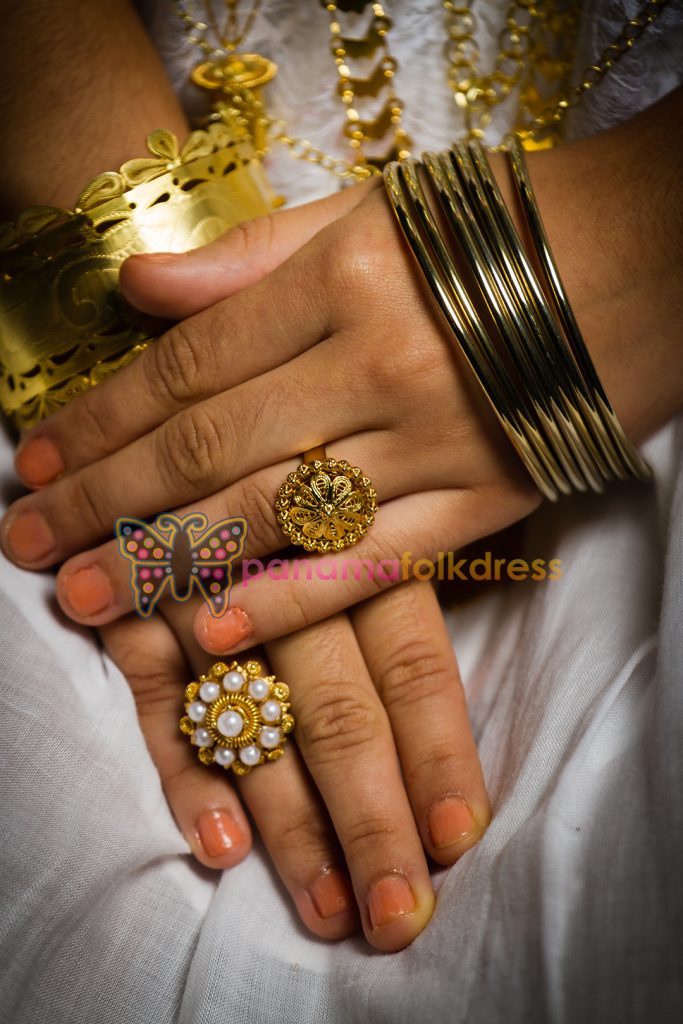
The Witch Chain: is a variant of the flat chain with elongated Z-shaped links that add movement and change form. You can find them with a typical pin called “flor de Guate” (guate flower). At both ends they have a small bell worked with a golden sheet, filigree and shiny plates.
The Rosary: It is believed that the custom of wearing the rosary with the Pollera was copied from the gypsies. In our opinion it has followed the path of the scapulars, both related to our religious jewelry.
In Panama there is great admiration to the work of the rosaries that empolleradas use. The filigree ones made in the workshops of the Castro brothers Pedasi are very famous, Villarreal from La Palma and Pablo Epifanio from Las Tablas.
The filigree rosary is the most popular, but pearl and coral with filigree rival in beauty and value. The rosary used in the empolleradas has no Christ on them, just a cross worked in any of the techniques of the fine jewelry.
The tapeworm chain (solitaria): This is another variant of the flat chain. It consists of a series of plates, near to a square, which will imitate the parasite called crawlers or tapeworms and terminating in a pair of golden bells. It is worn open or with a golden pin.
